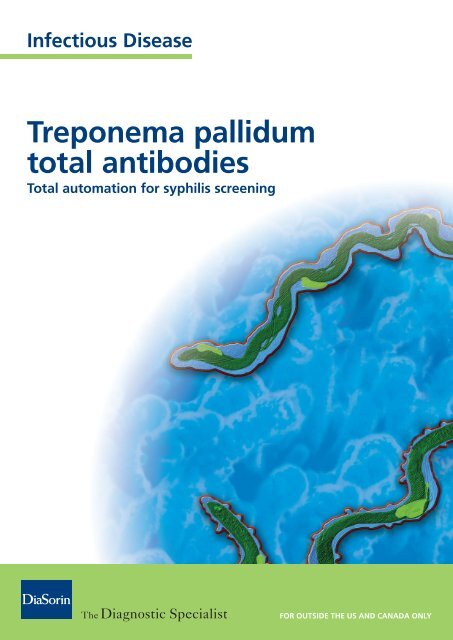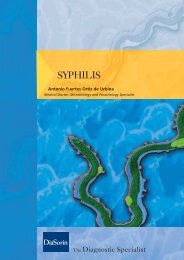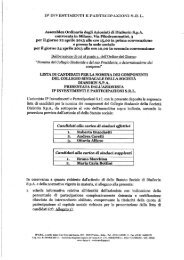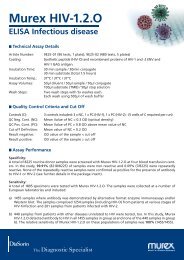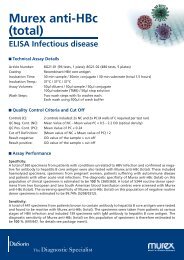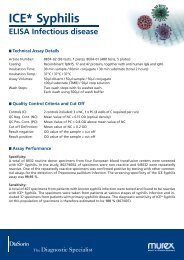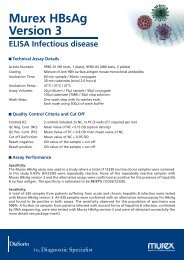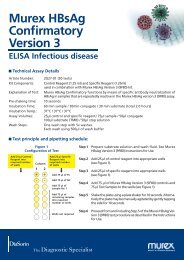Treponema Screen - DiaSorin
Treponema Screen - DiaSorin
Treponema Screen - DiaSorin
You also want an ePaper? Increase the reach of your titles
YUMPU automatically turns print PDFs into web optimized ePapers that Google loves.
Infectious Disease<br />
<strong>Treponema</strong> pallidum<br />
total antibodies<br />
Total automation for syphilis screening<br />
FOR OUTSIDE THE US AND CANADA ONLY
Infectious Disease<br />
Syphilis screening?<br />
<strong>Treponema</strong> screen is the solution<br />
Clinical background<br />
Syphilis is a chronic infectious disease caused by sexual or congenital<br />
transmission of the <strong>Treponema</strong> pallidum spirochetae, which<br />
remains a global problem with an estimated 12 million people<br />
infected each year, despite the existence of effective prevention<br />
measures and effective and relatively inexpensive treatment options.<br />
Serological testing is essential in the detection and control<br />
of syphilis infection.<br />
The 2008 European IUSTI/WHO recommendations suggest the<br />
treponemal antigen-based Enzyme/Chemiluminescence immunoassays<br />
or TPPA (preferred to TPHA) as appropriate as a single<br />
screening test. The RPR/VDRL is not recommended as a primary<br />
screening test. The Confirmatory test if any primary screening test<br />
is positive should be a treponemal antigen test of a different type<br />
from the primary screening test recommended. 1<br />
CDC, on the other hand, arguing that the use of only one type<br />
of serological test is insufficient for diagnosis, recommends traditional<br />
screening using a non-treponemal test followed by the<br />
testing of reactive sera with a treponemal test. However, when<br />
reverse sequence screening is used, as in some clinical laboratories<br />
and blood banks, CDC recommends the reflexive testing<br />
of all sera that give reactive EIA/CLIA results with a quantitative<br />
non-treponemal test, and the reflexive testing of sera that give<br />
discordant results (i.e., reactive EIA/CLIA and nonreactive RPR/<br />
VDRL test) with a confirmatory <strong>Treponema</strong> pallidum particle agglutination<br />
assay (TPPA). 2<br />
1. IUSTI/WHO European STD Guidelines: 2008 European Guideline on the Management of Syphilis<br />
2. MMWR / February 11, 2011 / Vol. 60 / No. 5<br />
IUSTI/WHO 2008 recommendations CDC-recommended algorithm for reverse sequence syphilis<br />
screening<br />
EIA/CLIA/TPPA<br />
--<br />
EIA/CLIA/TPPA<br />
EIA/CLIA/TPPA<br />
--<br />
EIA/CLIA/TPPA<br />
+<br />
Confirmatory with different type<br />
of treponemal test<br />
Main Features<br />
Number of tests: 200<br />
Solid phase & conjugate: recombinant antigens<br />
Label: Isoluminol derivative<br />
Method: one-step sandwich chemiluminescence<br />
immuno assay (CLIA)<br />
Ordering information<br />
EIA/CLIA/TPPA<br />
+<br />
Quantitative<br />
TPPA<br />
Test for serological activity of Syphilis<br />
quantitative RPR/VDRL<br />
Test for monitoring the serological response<br />
to treatment quantitative RPR/VDRL<br />
RPR<br />
+<br />
Syphilis<br />
(past or present) §<br />
EIA/CLIA<br />
+<br />
Quantitative RPR<br />
or other non<br />
treponemal test<br />
TPPA<br />
+<br />
Syphilis<br />
(past or present)<br />
EIA or CLIA<br />
RPR<br />
--<br />
TPPA<br />
EIA/CLIA<br />
-- †<br />
TPPA<br />
--<br />
Syphilis unlikely <br />
Abbreviations:<br />
EIA/CLIA = enzyme immunoassay/chemiluminescence<br />
immuno assay; RPR = rapid plasma<br />
reagin; TPPA = <strong>Treponema</strong><br />
pallidum particle agglutination;<br />
VDRL = Venereal Disease<br />
Research Laboratory.<br />
† If incubating or primary syphilis<br />
is suspected, treat with<br />
benzathine penicillin G 2.4<br />
million units intramuscularly<br />
in a single dose.<br />
§ Evaluate clinically, determine<br />
whether treated for syphilis in<br />
the past, assess risk for infection,<br />
and administer therapy<br />
according to CDC’s 2010 STD<br />
Treatment Guidelines (available<br />
at http://www.cdc.gov/<br />
std/treatment/2010).<br />
If at risk for syphilis, repeat<br />
RPR in several weeks.<br />
Quick and reliable results made possible by flexibility<br />
Diagnostic Specificity: 99.91% (95% C.I.: 99.75 - 99.98%)<br />
Diagnostic Sensitivity: 99.40% (95% C.I.: 96.73 - 99.98%)<br />
Reagent stability on board: minimum 4 weeks or more if<br />
controls are found within the expected ranges<br />
LIAISON ® <strong>Treponema</strong> <strong>Screen</strong> (code 310840) LIAISON ® Control <strong>Treponema</strong> <strong>Screen</strong> (code 310841)<br />
AVAILABLE ON<br />
SYSTEMS<br />
Product availability subject to required regulatory approvals<br />
<strong>DiaSorin</strong> S.p.A.<br />
Via Crescentino<br />
13040 Saluggia (VC) - Italy<br />
Tel. +39.0161.487526<br />
Fax: +39.0161.487670<br />
www.diasorin.com<br />
E-mail: info@diasorin.it<br />
M0870004184/B 12159 0412


